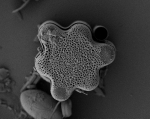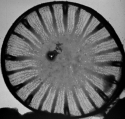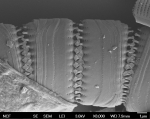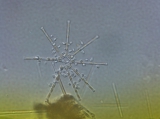
iBet uBet web content aggregator. Adding the entire web to your favor.
Link to original content: https://www.diatombase.org







The diatoms are an amazing group of organisms, part of the Stremenopile lineage of life. These photosynthetic unicells (ranging from 1 µm to over 1 mm in size) have chlorophylls a and c, and a complement of accessory pigments that include xanthophylls and carotenoids, making the living cells golden-brown in color. They produce bipartite glass cell walls and their products from photosynthesis are lipids. Some have suggested diatoms have the most efficient photosynthetic machinery of any group of organisms. Diatoms are found in marine, estuarine and freshwater ecosystems, inhabiting a wide range of environmental conditions. Because they are found in almost any place that has, or has had, water, and due to their efficient photosynthetic processes, they are important players in the global cycling of carbon and oxygen. And because they require silicon dioxide for cell division, they are also important players in the global cycling of silica. So, despite their small size they are important components in resource cycling globally.
In most aquatic ecosystems, diatoms along with other algae are the base of the food chain. As primary producers, they are important links between the abiotic and biotic worlds. In that crucial position (in addition to their short generation times), they can be important indicators of environmental change (see below). Diatoms are preferentially selected by primary consumers, in part due to the rich oil they produce.
The group, overall, occupies tremendous ecological breadth. In inland systems, diatoms can be found all over the world, from the tropics to the poles, across a wide range of habitats included many lentic environments such as large to small lakes, bogs, springs and fens, and in lotic environments, from headwater streams to the mouth of great rivers. Along a temperature gradient, they have been recognized growing in ice, and are some of the first eukaryotes to be found in hot springs. In terms of salinity, they have been found in salty inland lakes, where the salinity can be several times greater that the ocean, and in some of the most dilute freshwaters. Diatoms are found in some of the most natural, pristine environments, and in the outfalls of primary sewage treatment plants. They have been found over eight orders of magnitude relative to hydrogen ion concentration, in very low pH waters (ca. 2.5 in acid mine drainage) to alkaline systems where the pH is above 10 (above this pH the silica in their cell walls dissolves).
Due to their siliceous cell walls, an extensive fossil record of diatoms has been developed, in both marine and freshwaters. The marine fossil diatom record extends back to the Jurassic. Fossil outcrops of the marine record occur on every continent, and many cores from the oceans, taken during the Deep-Sea Drilling program and Ocean Drilling Programs. There are many more genera of marine diatoms than freshwater diatoms. In the freshwater realm, the record is much younger, with the oldest known records occurring from the Eocene. Marine and freshwater deposits can be extensive in area and depth, and many economically-valuable resources are derived from these diatomaceous deposits.
In addition to these wide spectra of environmental conditions, diatoms occupy a wide range of physical niches in aquatic ecosystems. They have adaptations for existing in the plankton, floating or drifting near the surface of waters of lakes and large rivers. They are found in high-energy zones of shorelines and fast-flowing water, attached by a variety of mechanisms to stones, rocks, wood and other plant-life and algae. In more quiescent waters, diatoms can inhabit the benthic environment, either as resting spores or in some cases, those species with a raphe can move, micro-positioning themselves in the sediments or other substrates.
In addition to the physical and chemical components of the habitats where diatoms occur, there are biological elements as well. For example, diatoms may use different carbon sources and there are a few species that are entirely heterotrophic, living amongst the muco-polysaccharides of seaweeds. They may be involved in a variety of symbioses, either loose associations (for example inhabiting the mucilage of colonial protozoans), being harbored by organisms (such as dinoflagellates) or harboring blue-green algae (some diatoms even integrating their symbionts as nitrogen-fixing organelles).
Given the global distribution, wide ecological breadth, and important ecological roles, it should be no surprise that the diatoms are phylogenetically diverse. There have been over 75,000 named taxa in the group, and some estimates suggest there might exist over 200,000 species. One Order, the Bacillariales, for example, has more described species than all of the mammals combined.
While as a group the diatoms are widely distributed, individual species have their own preferences and tolerances to environmental conditions. Diatoms are quick responders to environmental change. Understanding individual species responses as well as community responses has been an underlying approach to using diatoms to study the status and trends of aquatic ecosystems. Diatoms have been used for more than a century to evaluate water quality and there is a tremendous body of literature on this topic across several continents and many countries, and this approach has been used for assessing current conditions in many freshwater, estuarine and marine environments. With fossils, as well as some long-term monitoring efforts, diatoms have been used not only to hindcast past conditions but to forecast trends of environmental change.
Applications of diatoms go far beyond water quality assessment. Their fossil remains (of marine and freshwater origin), known as diatomaceous earth, have many material applications, from insulation, to abrasives to filtration. Their ability to produce lipids via photosynthesis has drawn considerable attention to the use of diatoms as sources of renewable biofuels and the lipids cells for many times the price of petroleum as sources of Omega-3 oils as dietary supplements. They are being used in nanotechnology and medicine, both for their glass cell walls and for the bio-active products they produce.
Research interests with diatoms include nanotechnology, biodiversity and habitat conservation and, due to their temporal and spatial compactness, they are used to study ecological phenomenon both from theoretical and practical points of view. Molecular studies search to find and evaluate the genetic and physiological machinery for a wide range of activities, from oil production, to uptake and metabolism in responding to temperature and nutrient levels and fluctuations, to the transformation of genomes. And a revolution in our understanding of their phylogenetic relationships is taking shape, surely to upend classical approaches to their classification.
Fourtanier and Kociolek (2009) provide a history of the development of catalogues of diatom names (starting in the early 1800’s with the work of Agardh and Bory), and including the major published catalogues focused on diatoms, including those of Habirshaw, Peragallo, Mills and Vanlandingham. The work of Ruth Patrick at the Academy of Natural Sciences to establish and build a catalogue of species described after 1932 (summarized by Potapova et al. 2017 and the work of Paul Silva and the development of the Index Nominum Algarum were also major resources for diatom names. The Catalogue of Diatom Names (Fourtanier and Kociolek 2011) was built as an on-line resource, integrating and cross-checking the above resources, and including verification of information across 12,500 references. Over 64,000 names of diatom taxa were included in the Catalogue of Diatom Names, which lists the names, describers, publication and homotypic synonyms for the names.
DiatomBase is an attempt to integrate the Catalogue of Diatom Names, and include names that have appeared since the Catalogue of Diatom Names was last updated (2011), as well as to include information about types, ecology, images, original descriptions and distributions. Since it is supported by VLIZ, it is also an objective to understand what names in DiatomBase are accepted names as well as their broad ecological distributions. Determining the accepted names is a process that will include recognizing not only homotypic synonyms but also heterotypic synonyms. To date, there are over 74,000 names in DiatomBase. It is the work of the editors, with help from our community, to incorporate new entries, resolve discrepancies, and add additional information to the current entries to make DiatomBase a wide-ranging resource for work on diatoms.
For each diatom species or infraspecific taxon, accepted or not, there may be the following entries:
Cox, E.J. (2015). Coscinodiscophyceae, Mediophyceae, Fragilariophyceae, Bacillariophyceae (Diatoms). In: Syllabus of Plant Families. Adolf Engler's Syllabus der Pflanzenfamilien. 13th Ed. Photoautotrophic eukaryotic algae Glaucocystophyta, Cryptophyta, Dinophyta/Dinozoa, Heterokontophyta/Ochrophyta, Chlorarachniophyta/Cercozoa, Euglenophyta/Euglenozoa, Chlorophyta, Streptophyta pp. (Frey, W. editor), pp. 64-103. Berlin: Borntraeger Science Publishers.
Fourtanier, E. & Kociolek, J.P. (2009). Catalogue of diatom names. Part 1. Introduction and Bibliography. Occasional Papers of the California Academy of Sciences 156: 1-168.
Fourtanier, E. & Kociolek, J.P. (2011). Catalogue of Diatom Names, California Academy of Sciences, On-line Version updated18 September 2011. Available online at http://researcharchive.calacademy.org/research/diatoms/names/index.asp
Potapova, M.G., Minerovic, A.D., Veselá, J., Smith, C.R. (Editors) (2018). Diatom New Taxon File at the Academy of Natural Sciences (DNTF-ANS), Philadelphia. Retrieved on YYYY-MM-DD from http://symbiont.ansp.org/dntf.